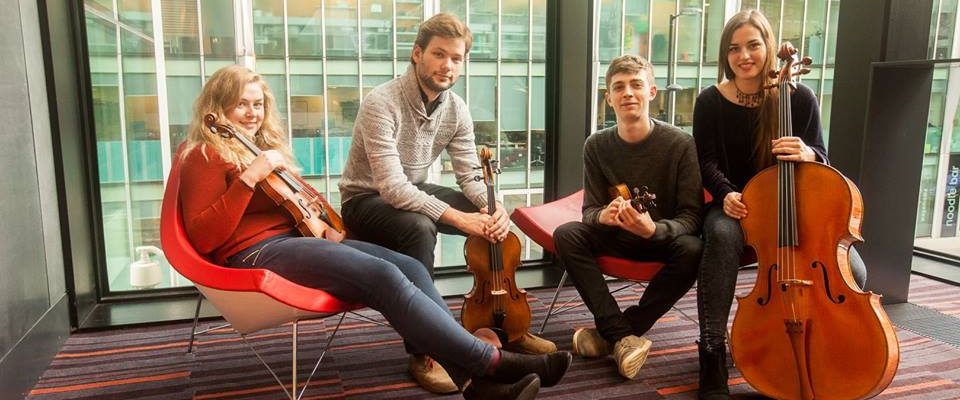Music as Therapy: Brass-tastic Experience for Linden Lodge Pupils (Wandsworth 2024)
 Musicians’ Company Young artists Josh Allen (tuba) and Joe Skypala (trumpet) teamed up with Linden Lodge pupils for an eight-week music-making session. Exploring the unique sounds and sensations of brass instruments, the project was delivered as part of our Music as Therapy partnership (Lewisham). Josh tells us more.
Musicians’ Company Young artists Josh Allen (tuba) and Joe Skypala (trumpet) teamed up with Linden Lodge pupils for an eight-week music-making session. Exploring the unique sounds and sensations of brass instruments, the project was delivered as part of our Music as Therapy partnership (Lewisham). Josh tells us more.
“The tuba usually sparks curiosity amongst primary age children who are eager to see the instrument up close. Adding to the excitement of this fun Music as Therapy project was Joe’s equally shiny trumpet, volunteer Richard Lea and class teachers Vicky and Jakub
This was my second visit to Linden Lodge. Last year saxophonist Sophia Elgar and I joined Year 1 and 2 PMLD students for a seven-session course. For this project, we delivered eight sessions across two SEND groups of six pupils. All the pupils have sensory impairments.
The tuba is perfect for engaging the senses. Aside from being big and shiny, it produces a deep, booming sound. During our first session I invited the pupils to touch and knock the tuba, or to get up close and see their reflection. Its lovely curves add to its sensory appeal.
Planning any school music project involves a bit of guesswork. You never know how things will unfold on the day. As each pupil had mixed needs and abilities, working out how we could help them get the most from each session was a rewarding challenge. We needed to think on our feet and adapt the plan as we went along.
We began each session with a familiar ‘Hello’ song such as a duet of ‘When the Saints Come In’. Richard would usually sing. We then connected our activities to the Sounds of Intent framework to engage with the pupils more meaningfully. The small class size numbers made it easier for us to adapt the sessions to individual needs.
Moving forward, we involved the pupils with Sounds of Intent ‘copy me, copy you’ activities, including the start-stop music game and ones that contrast quiet and louds sounds. It quickly became clear that some students struggled to hear very low pitches, while others had difficulty with very high ones. This led us to explore alternative ways to engage the pupils with sound.
 Circling the room with our tuba and trumpet, we pressed them against the metal of the pupils’ wheelchairs – you can get a similar effect on drum skins – so they could experience the vibrations firsthand. This brought a multi-sensory approach to the sessions and kept the music activity accessible to those who couldn’t hear a certain pitch.
Circling the room with our tuba and trumpet, we pressed them against the metal of the pupils’ wheelchairs – you can get a similar effect on drum skins – so they could experience the vibrations firsthand. This brought a multi-sensory approach to the sessions and kept the music activity accessible to those who couldn’t hear a certain pitch.
We also had fun making rainforest sounds using handheld percussion instruments. This enabled us to explore the dynamics of their music-making. Could they use their instruments to create quiet and loud sounds? How about slow and fast? One girl particularly enjoyed the shaker, so we encouraged her to try tapping her foot as she shook.
Keeping activities simple was important. Reaction times are often slower with SEND pupils, so we adjusted our pace to help keep them engaged. We sometimes repeated activities as often as five or six times, revisiting them later to help build their confidence and encourage participation and learning using different instruments.
Playing more and talking less was also important. Jakub assured us that for some pupils just sitting and listening to the music was a big enough achievement. Moreover, minimising verbal communication reduced the time spent processing words. All the pupils had strong facial expressions, making it easy for us to tell if they were enjoying an activity or not!
This was a fantastic project showing how interactive activities involving all the senses can help people who find it hard to access music in conventional ways. The team all gained so much from this project, as did the pupils. The number of beaming smiles around the room really did say it all.”
Interview by Suzy Willmott
Suzy is freelance copywriter who works with the Musicians’ Company





